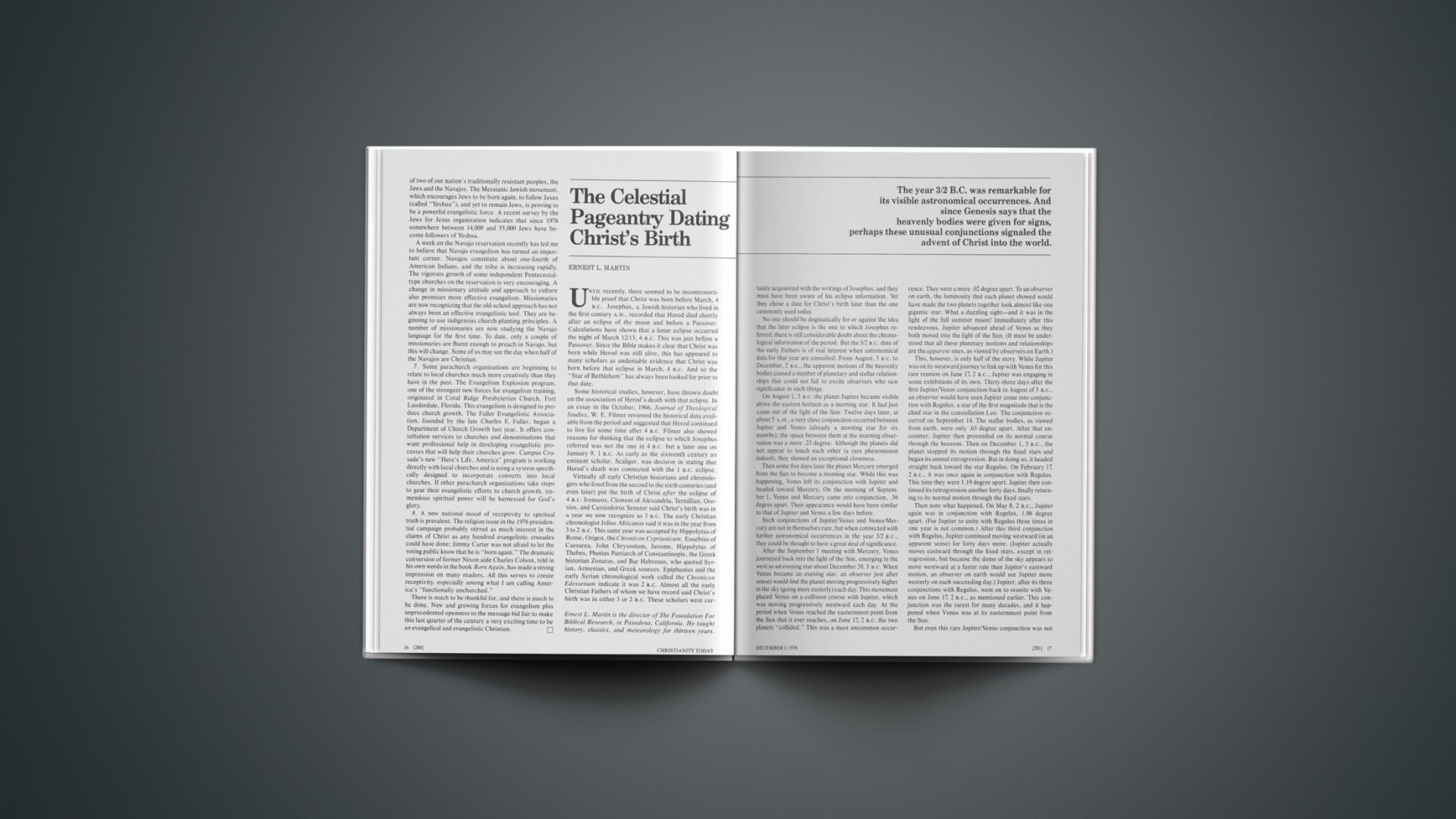Until recently, there seemed to be incontrovertible proof that Christ was born before March, 4 B.C. Josephus, a Jewish historian who lived in the first century A.D., recorded that Herod died shortly after an eclipse of the moon and before a Passover. Calculations have shown that a lunar eclipse occurred the night of March 12/13, 4 B.C. This was just before a Passover. Since the Bible makes it clear that Christ was born while Herod was still alive, this has appeared to many scholars as undeniable evidence that Christ was born before that eclipse in March, 4 B.C. And so the “Star of Bethlehem” has always been looked for prior to that date.
Some historical studies, however, have thrown doubt on the association of Herod’s death with that eclipse. In an essay in the October, 1966, Journal of Theological Studies, W. E. Filmer reviewed the historical data available from the period and suggested that Herod continued to live for some time after 4 B.C. Filmer also showed reasons for thinking that the eclipse to which Josephus referred was not the one in 4 B.C. but a later one on January 9, 1 B.C. AS early as the sixteenth century an eminent scholar, Scaliger, was decisive in stating that Herod’s death was connected with the 1 B.C. eclipse.
Virtually all early Christian historians and chronologers who lived from the second to the sixth centuries (and even later) put the birth of Christ after the eclipse of 4 B.C. Irenaeus, Clement of Alexandria, Tertullian, Orosius, and Cassiodorus Senator said Christ’s birth was in a year we now recognize as 3 B.C. The early Christian chronologist Julius Africanus said it was in the year from 3 to 2 B.C. This same year was accepted by Hippolytus of Rome, Origen, the Chronicon Cyprianicum, Eusebius of Caesarea, John Chrysostom, Jerome, Hippolytus of Thebes, Photius Patriarch of Constantinople, the Greek historian Zonaras, and Bar Hebreaus, who quoted Syrian, Armenian, and Greek sources. Epiphanius and the early Syrian chronological work called the Chronicon Edessenum indicate it was 2 B.C. Almost all the early Christian Fathers of whom we have record said Christ’s birth was in either 3 or 2 B.C. These scholars were certainly acquainted with the writings of Josephus, and they must have been aware of his eclipse information. Yet they chose a date for Christ’s birth later than the one commonly used today.
No one should be dogmatically for or against the idea that the later eclipse is the one to which Josephus referred; there is still considerable doubt about the chronological information of the period. But the 3/2 B.C. date of the early Fathers is of real interest when astronomical data for that year are consulted. From August, 3 B.C. to December, 2 B.C., the apparent motions of the heavenly bodies caused a number of planetary and stellar relationships that could not fail to excite observers who saw significance in such things.
On August 1, 3 B.C. the planet Jupiter became visible above the eastern horizon as a morning star. It had just come out of the light of the Sun. Twelve days later, at about 5 A.M., a very close conjunction occurred between Jupiter and Venus (already a morning star for six months); the space between them at the morning observation was a mere .23 degree. Although the planets did not appear to touch each other (a rare phenomenon indeed), they showed an exceptional closeness.
Then some five days later the planet Mercury emerged from the Sun to become a morning star. While this was happening, Venus left its conjunction with Jupiter and headed toward Mercury. On the morning of September 1, Venus and Mercury came into conjunction, .36 degree apart. Their appearance would have been similar to that of Jupiter and Venus a few days before.
Such conjunctions of Jupiter/Venus and Venus/Mercury are not in themselves rare, but when connected with further astronomical occurrences in the year 3/2 B.C., they could be thought to have a great deal of significance.
After the September 1 meeting with Mercury, Venus journeyed back into the light of the Sun, emerging in the west as an evening star about December 20, 3 B.C. When Venus became an evening star, an observer just after sunset would find the planet moving progressively higher in the sky (going more easterly) each day. This movement placed Venus on a collision course with Jupiter, which was moving progressively westward each day. At the period when Venus reached the easternmost point from the Sun that it ever reaches, on June 17, 2 B.C. the two planets “collided.” This was a most uncommon occurrence. They were a mere .02 degree apart. To an observer on earth, the luminosity that each planet showed would have made the two planets together look almost like one gigantic star. What a dazzling sight—and it was in the light of the full summer moon! Immediately after this rendezvous, Jupiter advanced ahead of Venus as they both moved into the light of the Sun. (It must be understood that all these planetary motions and relationships are the apparent ones, as viewed by observers on Earth.)
This, however, is only half of the story. While Jupiter was on its westward journey to link up with Venus for this rare reunion on June 17, 2 B.C., Jupiter was engaging in some exhibitions of its own. Thirty-three days after the first Jupiter/Venus conjunction back in August of 3 B.C., an observer would have seen Jupiter come into conjunction with Regulus, a star of the first magnitude that is the chief star in the constellation Leo. The conjunction occurred on September 14. The stellar bodies, as viewed from earth, were only .63 degree apart. After that encounter, Jupiter then proceeded on its normal course through the heavens. Then on December 1, 3 B.C., the planet stopped its motion through the fixed stars and began its annual retrogression. But in doing so, it headed straight back toward the star Regulus. On February 17, 2 B.C., it was once again in conjunction with Regulus. This time they were 1.19 degree apart. Jupiter then continued its retrogression another forty days, finally returning to its normal motion through the fixed stars.
Then note what happened. On May 8, 2 B.C., Jupiter again was in conjunction with Regulus, 1.06 degree apart. (For Jupiter to unite with Regulus three times in one year is not common.) After this third conjunction with Regulus, Jupiter continued moving westward (in an apparent sense) for forty days more. (Jupiter actually moves eastward through the fixed stars, except in retrogression, but because the dome of the sky appears to move westward at a faster rate than Jupiter’s eastward motion, an observer on earth would see Jupiter more westerly on each succeeding day.) Jupiter, after its three conjunctions with Regulus, went on to reunite with Venus on June 17, 2 B.C., as mentioned earlier. This conjunction was the rarest for many decades, and it happened when Venus was at its easternmost point from the Sun.
But even this rare Jupiter/Venus conjunction was not all. On August 27, 2 B.C., Jupiter emerged once again as a morning star. Mars, which had played no active part in the past year’s conjunctions, overtook Jupiter and formed a very close conjunction with it; the two planets were only .14 degree apart. Such nearness is not an ordinary occurrence, and it must have been a wonderful sight. Since the planets were only eight degrees ahead of the Sun, the light for the predawn probably diminished the display for the observer on earth. Yet astronomers in that period could have calculated the time of the conjunction and may have been looking for it.
These astronomical indications show that seven major conjunctions took place in 3/2 B.C. That year must have been an unusual and interesting one to astronomers—and even more so to astrologers. And this is where the Wise Men of the New Testament come into the picture.
Since most people in the first century believed in astrology as a scientific indicator of important events, these displays of 3/2 B.C. must have produced a good deal of excitement. Even the writers of the New Testament may have shared in it. The New Testament says that wise men (Magi) came to Jerusalem looking for a newborn king. History shows that the Magi were astrologers, and the New Testament says that some of them journeyed to Jerusalem asking for the king of the Jews, whom they wished to worship (Matt. 2:2). Suetonius (Vespasian iv) and Tacitus (Histories v 13), two Roman historians who lived in the first century, said there had long been a belief throughout the East (Palestine, Syria, Babylon) that near the first century a king would be born of the Jews who was destined to rule the world. Virgil also told of the dawning of the golden age in that period (Eclogue iv). Since such a belief was widespread, there is little doubt that the astrologers looked for astronomical signs concerning the arrival of the prophesied king.
The Gospel of Matthew says the Magi saw a particular star that was the signal of the king’s coming. The Greek words used in relating the event were the ordinary ones used throughout Greek literature to describe the regular rising of the stars or planets (Kittel, Theological Dictionary, I, 352). In their normal predawn observations the Magi could very well have seen an ordinary star (or planet) ascending above the eastern horizon, which they interpreted as the sign that the prophesied Jewish king was to be born. They were certain enough of their interpretations to make a long, arduous journey with costly gifts to present to the new king. The Bible says that Herod and all Jerusalem also took the sign of the star seriously.
What star could this have been?
The ingenious German astronomer Kepler back in 1606 A.D. suggested that the star of the Magi was a conjunction of Jupiter and Saturn appearing near some other star. In the last century, Ideler found that such a conjunction did occur in 7 B.C. But this year is very early for the birth of Christ, and later it was found that the planets Jupiter and Saturn were then at least two diameters of the moon away from each other. This was too far away for anyone to view them as a “star.” Some have suggested that the Bible is talking about a comet, but this is unlikely because comets were almost always interpreted as harbingers of evil. Perhaps it was an exploding star, a nova. Yet this suggestion is unprovable, and most scholars reject the idea. Some even feel it was an angel. Others say it was an outright miracle.
But let us recall a simple fact that the Gospel says happened: the Magi saw “his star” rising in the east. The text reads as if it were an ordinary morning star. Perhaps the star was a normal heavenly body that was in some kind of unusual configuration. Because 3/2 B.C. was an extraordinary year for visible astronomical occurrences, and since most early Christian writers say Christ was born in this year, perhaps we should focus our attention there.
Let us notice some astrological and biblical factors connected with the astronomical signs of 3/2 B.C. Since the New Testament shows that the “star” rose in the East, it would naturally be called a morning star. Christ said of himself, “I am the root and offspring of David, and the bright and morning star” (Rev. 22:16). We should recall that in 3 B.C. on the morning of August 12, eighty minutes before sunrise, Jupiter rose as a morning star in conjunction with Venus. How would astrologers (or Magi) interpret such a phenomenon? Astrological interpretation can vary widely, but let us notice some generally accepted beliefs.
Jupiter, known astrologically as the Father of the Gods, left the vicinity of the Sun and conjoined with Venus. This could be associated with a coming birth. In fact, “Jupiter was often associated with the birth of kings and therefore called the King-planet” (Hendriksen, Matthew, p. 153). Jupiter and Venus were also known as the Greater and Lesser Good Fortunes of the astrologers, and here they were in union. And note this: while this conjunction was occurring, the Sun (the Supreme Father), the Moon (considered a Mother), and Mercury (the Messenger of the Gods) were located in the single constellation of Leo—the Lion. The fact that these primary bodies were clustering in Leo may have had some biblical significance. The lion was the symbol of the tribe of Judah. Christ was called “the Lion of the tribe of Judah, the Root of David” (Rev. 5:5).
Then twenty days later another interesting thing occurred. Mercury (the Messenger of the Gods) left its position with the Sun (the Supreme Father) and moved into close conjunction with Venus. To the Chaldeans, Venus was Ishtar, the Virgin Mother—the goddess of fertility. However, the planet normally was thought to take on masculine qualities as a morning star. It was feminine in the evening. But notice what happened to the Sun when the Mercury/Venus conjunction took place. The Sun (the Father) had entered the constellation Virgo (the Virgin). This occurred when Mercury (the Messenger) and Venus were now conjoined in the constellation of Leo (the Lion) and Jupiter itself was just then entering Leo. All these astral signs have biblical themes associated with them. The Supreme Father in the Bible is God the Father. His Son was to be born of a virgin, according to prophecy. He was to be a descendant of Judah (Leo, the Lion), and he was to be introduced by a messenger (“Behold, I send my messenger before thy face, which shall prepare thy way before thee”—Mark 1:2).
Following these planetary conjunctions, Jupiter then moved on (as we have shown earlier) to unite with the star Regulus on September 14, 3 B.C. This could have been a very significant event—especially in relation to the other conjunctions of the year. Regulus is the chief star in the constellation of Leo, and Leo was connected with Judah in the Hebrew zodiac.
The brightest star in the constellation of Leo is Regulus, known as “the Heart of the Lion.” The Babylonians referred to Regulus as “the King,” and the Romans called it Rex, “King.” In Arabia, Regulus was known as “the Kingly One.” The Greeks called it “Basiliscos Aster,” which means “King Star.” Of all the stars in the heavens, Regulus was the one universally connected by ancient astrologers with greatness and power. And it was clearly connected with the conception or birth of kings.
Here was the King planet Jupiter, which had recently united with Venus, now associating itself with the King star in the constellation of Leo (the tribe of Judah). At the time of this conjunction, the Sun (the Supreme Father) was positioned in the constellation of Virgo (the Virgin). All these features are very reminiscent of biblical themes associated with Christ.
But these are not all the signs of 3/2 B.C. After Jupiter’s three conjunctions with Regulus (the King star), Jupiter continued its westward journey, and on June 17, 2 B.C., it had its rare reunion with Venus. The planet Venus (now called the Mother, an evening star) was extending as far east as possible to meet her consort, Jupiter, the King planet. What occurrred was a splendid planetary conjunction visible to all on earth that, let us note again, occurred in the constellation Leo—the sign of Judah. The conjunction also happened at the exact time of the full moon. The two planets would have appeared almost as one gigantic star. Could it be that these same planets that had introduced the prophesied king when they were both morning stars some nine and two-thirds months ago were now finalizing that introduction of the newborn king with an impressive evening-star union?
This, however, was not the end. On August 27, 2 B.C. (seventy-two days later), observers would have seen the extremely close conjunction of Jupiter with Mars (the planet of War). This occurred just before sunrise, close to the Sun. If the planets had not been close together, they would ordinarily not have been seen from earth. But they were then in very close conjunction, and because of that their light could have shone through the predawn.
As a matter of fact, there were actually four planets near the same longitude in the heavens when Jupiter and Mars had their conjunction: Jupiter at 142.6 degrees; Mars, 142.56; Venus, 141.51; and Mercury, 144.28. For these four planets to be so close was an unusual occurrence. And remarkably, those planets clustering around one another were all located in the constellation of Leo the Lion while the Sun at that very time was entering the sign of Virgo the Virgin! These factors too could emphasize biblical events.
What could be the interpretation here? Since Jupiter and Mars had just become new morning stars, it could well signify that war would break out on the earth just before that prophesied messianic day could commence. At least the Bible predicts that this will happen—and astrologers may have interpreted the sign similarly.
One thing is certain: the year 3/2 B.C. was remarkable for its visible astronomical occurrences. And since Genesis 1:14 says that the heavenly bodies were given for signs, perhaps these unusual conjunctions were intended to signal the advent of the Christ Child into the world. The stellar body that played the most prominent role in this extraordinary year was Jupiter. It could well be that Jupiter was “his star” that the Magi followed to Jerusalem, and finally to Bethlehem.
Let us now look at some interesting biblical features that could be said to support this interpretation. It should be recognized that the Magi arrived in Jerusalem sometime after Christ was born (Matt. 2:2). He had been circumcised (Luke 2:21) and presented at the Temple (Luke 2:22–24). The parents of Christ were living in a house, not a manger (Matt. 2:11), and Christ was then called a paidon (child), not a brephos (infant). After the Magi presented their gifts, they returned home by a different route. In response to this subterfuge, Herod slew the infants around Bethlehem who were two years of age and younger (Matt. 2:16). Since it was often difficult to interpret whether heavenly signs were indicating conception or birth, Herod probably took both possibilities into account: he killed the children up to two years so as to include both the time of conception and the time of birth. All these indications show that the Magi must have arrived in Bethlehem several months after Christ’s birth.
This leads us to the final indication that the planet Jupiter may be the “Star of Bethlehem.” Recall that the Magi saw the star rise above the eastern horizon. And in August, 3 B.C., Jupiter did in fact rise as a morning star that soon came into conjunction with Venus. That started a series of six conjunctions with other planets and the star Regulus. The last planetary conjunction was the one with Mars in August, 2 B.C., but then something else happened with Jupiter: Jupiter left its conjunction with Mars and proceeded in its apparent motion westward. The Bible says the star “went ahead of them” (Matt. 2:9). Could it be that the Magi (who came from the East) simply followed the normal movements of Jupiter as it progressed westward each day? The text could be interpreted this way.
Then note what occurred. When they reached Jerusalem, the Magi were told to look toward Bethlehem for the newborn king. This happened at a time when the New Testament says the star came to a definite halt in the heavens—it “stood over where the young child was” (Matt. 2:9). And indeed, the planet Jupiter does become stationary in its motion through the fixed stars. This happens at its times of retrogression and progression. It could well be that Matthew was referring to such a thing.
Jupiter had come to the point of retrogression; it became stationary among the stars. It was now about to display its seventh and final sign of that extraordinary year. The precise time for the retrogression of Jupiter was December 25, 2 B.C.! On that day Jupiter became stationary in the heavens.
But how was it possible for Jupiter to be stationary over the village of Bethlehem at that time? Very simple. The Bible says the Magi saw the star while they were still in Jerusalem (Matt. 2:8, 9). Bethlehem is located five miles south of Jerusalem. And on December 25, 2 B.C., at the ordinary time of the Magi’s predawn observations, Jupiter would have been seen in meridian position (directly over Bethlehem) sixty-five degrees above the southern horizon. This position would have shown the planet shining right down on Bethlehem! Furthermore, it was the period of the winter solstice, and so not only Jupiter but also the Sun was “standing still” in the heavens. (The word solstice comes from Latin words meaning “Sun stands still.”) This occurrence could well have appeared significant to astrologers. “General observance required that on the 25th of December the birth of the ‘new Sun’ should be celebrated, when after the winter solstice the days began to lengthen and the ‘invincible star triumphed again over darkness’ ” (Cumont, Astrology and Religion Among the Greeks and Romans, p. 89). And now, both Jupiter and the Sun were “standing still,” and Jupiter was then situated in the constellation of Virgo the Virgin.
Would not astrologers have been impressed with these interesting heavenly relationships? The Magi could have interpreted them as the destined time for giving their gifts to the “newborn Sun”—this time the “Sun of righteousness” (Mal. 4:2), born of the Virgin Mary.
The astrological interpretations I have suggested in this article may or may not be correct, but the occurrence of these astronomical phenomena in 3/2 B.C. is certain. Those exhibitions no doubt caused a great deal of excitement and wonder. They may well indicate that the early Christian historians were correct when they said Christ was born sometime in the period 3/2 B.C.










